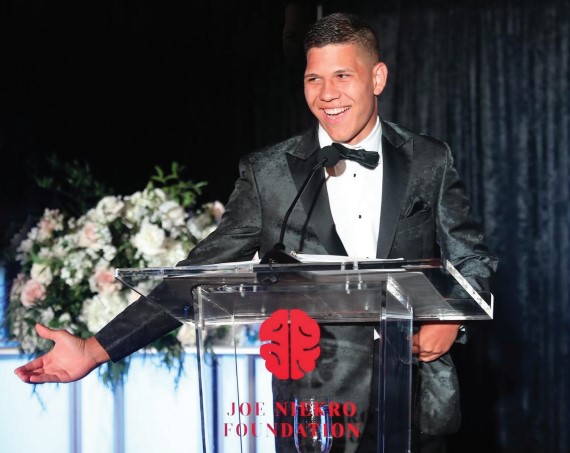Luc Wehby, Five Years Later
In April 2022, Jacquie Wehby chaired the Joe Niekro Foundation Gala held at the Four Seasons in Houston, and had the pleasure of watching her son, Luc Wehby, recognize Manish N. Shah, MD, with one of three Joe Niekro Foundation Patient Choice Awards.
Shah, associate professor of pediatric neurosurgery and the William J. Devane Distinguished Professor at McGovern Medical School at UTHealth Houston, led the affiliated team that saved 12-year-old Luc’s life after he suffered a ruptured aneurysm and intracranial hemorrhage in 2017.
 Shortly after 11 a.m. on May 11, 2017, Jacquie Wehby got a call from her son’s school nurse, saying that he had complained of head pain. As he stopped for a drink of water, he went down on one knee, screaming that his head hurt. He went limp on the left side and water dribbled from the left corner of his mouth.
Shortly after 11 a.m. on May 11, 2017, Jacquie Wehby got a call from her son’s school nurse, saying that he had complained of head pain. As he stopped for a drink of water, he went down on one knee, screaming that his head hurt. He went limp on the left side and water dribbled from the left corner of his mouth.
Recognizing the signs of stroke, the nurse called 911. Wehby later learned that her son was comatose and on the brink of death when he arrived at the Level 1 Pediatric Trauma Center at Children’s Memorial Hermann Hospital in the Texas Medical Center. Born with a previously undiagnosed arteriovenous malformation (AVM), Luc was one of the more than 50% of patients who have an AVM that ruptures, causing an intracranial hemorrhage.
“Luc had a very large hemorrhage deep below the surface on the right side of his brain,” says Shah, who directs the Texas Comprehensive Spasticity Center at McGovern Medical School and the Pediatric Epilepsy Surgery Program at Children’s Memorial Hermann Hospital. “In less than 10 minutes we had the results of his CT angiogram and he was on the operating table being prepped for a depressive craniectomy – removal of a portion of the skull to reduce damage to healthy areas of the brain by allowing it to swell without being squeezed. We moved quickly because we estimated that we had only a few minutes to save his life. Thanks to the CT angiogram, we were able to remove the blood clot safely to lower his intracranial pressure.”
The morning after the surgery, P. Roc Chen, MD, performed a cerebral angiogram, which showed the AVM was positioned on the optic nerve and frontal lobe, making surgical removal impossible. Chen is a professor in the Vivian L. Smith Department of Neurosurgery who specializes in endovascular, cerebrovascular, and skull base neurosurgery, and has expertise in AVMs, brain aneurysms, carotid disease, acoustic neuroma, and skull base tumors. Luc’s multidisciplinary treatment team agreed that Gamma Knife® radiosurgery was the best option after recovery from the craniectomy.
After two weeks at Children’s Memorial Hermann Hospital, Luc was admitted to a specialty rehab hospital, but after three weeks he developed intracranial swelling. Because Luc was not reabsorbing cerebrospinal fluid – a common occurrence after brain surgery for a large hemorrhage – Shah placed a ventriculoperitoneal shunt to relieve pressure on his brain. On June 22, Shah replaced the surgically removed portion of his skull, and Luc went home four days later. In mid-July, he was back at Children’s Memorial Hermann Hospital for the scheduled MRI and Gamma Knife radiosurgery. The surgery was performed by Chen and Angel Blanco, MD, a radiation oncologist in the Vivian L. Smith Department of Neurosurgery.
“Because Luc was treated so quickly, the deficits he might have suffered were greatly reduced. But the stroke left him with paralysis on his dominant side, and recovery is always an ongoing process,” Shah says.
Shah credits Luc’s recovery to his positive outlook and hard work in therapy, the rapid response of the school nurse who recognized the signs of stroke, and the pediatric emergency team at Children’s Memorial Hermann Hospital, which has logged an outstanding track record of moving patients with critical neurological problems from the doors of the ER to CT angiogram in the OR fast – in 10 minutes or less.
In 2018, Luc returned to school part time. By the time the COVID-19 pandemic hit in 2020, he was in school 4.5 hours a day. In 2021, Wehby decided to home-school Luc for his sophomore year of high school, and he continued therapy.
“He still has deficits on his left side, but he’s doing well emotionally and psychologically, and he’s accepted it,” Wehby says. “He’s becoming more and more independent, and he now plays golf one-handed for his high school team. He still loves fishing, and reels in his catch one-handed. He’s planning on going to college. We all think he’s pretty amazing!”
Jacquie and Kirk Wehby got involved with the Joe Niekro Foundation in 2018 after friends acquainted them with the organization following Luc’s neurosurgery. “We pitched in right away and helped with their gala. They were an incredible support to us and gave Luc a platform to recognize that he’s not alone, and also gave us the chance to realize we’re not alone as parents.
“The fundraiser was a great success, and it was an honor to chair the gala and preside over Luc’s presentation of the award to Shah,” Wehby says. “We were celebrating Luc’s five-year anniversary, and he gave a tribute to Dr. Shah as well. It was an amazing night!”
Contact Us
At UTHealth Neurosciences, we offer patients access to specialized neurological care at clinics across the greater Houston area. To ask us a question, schedule an appointment, or learn more about us, please call (713) 486-8000, or click below to send us a message. In the event of an emergency, call 911 or go to the nearest Emergency Room.











